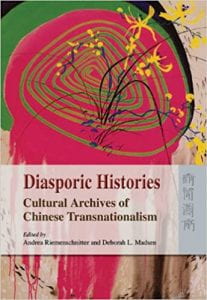 Today, the notion of transnationalism is ever increasing as immigration and globalization continue to rise. Cultural boundaries are blurring; the distinctions between the concepts of native, immigrant, and diaspora begin to fade. Thus, it is imperative for us to learn from individual cultures as well as the mix of these cultures. Moreover, people who have transnational and multicultural backgrounds have fluid identities, enabling them to relate with and be more culturally sensitive towards people from diverse backgrounds. They also have the perseverance and experiences in dealing with prejudice, separation, and displacement. These provide significant contributions to the discourses on transnationalism.
Today, the notion of transnationalism is ever increasing as immigration and globalization continue to rise. Cultural boundaries are blurring; the distinctions between the concepts of native, immigrant, and diaspora begin to fade. Thus, it is imperative for us to learn from individual cultures as well as the mix of these cultures. Moreover, people who have transnational and multicultural backgrounds have fluid identities, enabling them to relate with and be more culturally sensitive towards people from diverse backgrounds. They also have the perseverance and experiences in dealing with prejudice, separation, and displacement. These provide significant contributions to the discourses on transnationalism.
The book Diasporic Histories: Cultural Archives of Chinese Transnationalism discusses the important role of the Chinese diaspora in transnational discourses. Edited by Deborah Madsen and Andrea Riemenschnitter, this collection of twelve essays examines historical accounts and cultural representations of the Chinese diaspora, exploring how their identities and cultures have been shaped, preserved, and changed over time.
The book explores various historical accounts of the Chinese diaspora. Ping Kwan Leung’s essay “Writing across Borders: Hong Kong's 1950s and the Present” provides a new perspective and analysis on the cultural and linguistic characteristics of Hong Kong literature, disclosing the history of Chinese diaspora in Hong Kong. In the essay “Diaspora, Sojourn, Migration: The Transnational Dynamics of "Chineseness,” Deborah Madsen discusses how the concept of “Chineseness” can no longer be used to refer to a specific cultural identity since there are various factors including language, economy, and literary production which influence identity. Madsen explores the different meanings of sojourning, migration, and diaspora throughout history. Helen Siu, who has done extensive research on the history and ethnography of southern China and Hong Kong since the 1970s, analyzes several major oppositions against China’s political moves within the last few decades to indicate “how diaspora and centre, groundedness and displacement are mutually constitutive.” Prasenjit Duara’s essay “Between Sovereignty and Capitalism: The Historical Experiences of Migrant Chinese” contrasts the history of Chinese immigrants in Southeast Asia and the United States between the late 19th century and the first half of the 20th century. He further analyzes the relationships between capitalism with nationalism and colonialism.
Moreover, several essays review the history of Chinese immigration from as early as the Han Dynasty until the 18th century. Nicolas Zufferey, in his essay “Exile in China during the Han Dynasty,” attempts to present the feelings and conditions of the Chinese diaspora, especially their view towards their home and host countries during the Han Dynasty. Roland Altenburger examines the writings of Ji Yun, a mid-18th century Chinese scholar. Altenburger analyzes Ji Yun’s detailed documentation, including verses and prose, of his experiences during exile.
Besides historical narratives, some essays discuss cultural and literary representations. Mary Shuk-han Wong wrote “The Voyage to Hong Kong: Bildungsroman in Hong Kong Literature of the 1950s,” in which through the Bildungsroman perspective, she analyzes refugee literature (难民文学) of the mid-20th century that shares the experiences and conditions of mainland Chinese who escaped to Hong Kong. The essay “Women and Diaspora: Zhao Shuxia's Novel Sai Jinhua and the Quest for Female Agency” by Kathrin Ensinger explores the way Zhao Shuxia, a diasporic woman, retells the story of Sai Jinhua, a courtesan and a well-known figure who “offers a link between a complex tradition of courtesan culture with its strong ties to the male literati world of imperial China and modernity.” Ensinger further discusses how the life of a courtesan, including being displaced and separated from family, resembles that of the diasporic immigrants.
Furthermore, some essays examine more recent fiction narratives. Sau-Ling Wong explores a rare, yet crucial topic in her essay “The Yellow and the Black: Race and Diasporic Identity in Sinophone Chinese American Literature.” She analyzes how the identities of Chinese diaspora were constructed in some Chinese American fiction and how Black characters have a significant role in this notion of identity construction. The essay “Another Diaspora: Chineseness and the Traffic in Women in Fruit Chan's Durian Durian” by Pheng Cheah examines the condition of China’s small businesses after the Hong Kong Handover. Cheah also discusses the movie Durian Durian that represents Hong Kong’s unsteady economic condition during that era. Andrea Riemenschnitter’s essay studies Taiwanese and Hong Kong fiction writings within the past few years that are related to transculturalism and diaspora, especially their contribution to the discussion on queer transnationalism. In the last article “Double Diaspora? ‘Re-Presenting’ Singaporeans Abroad,” Tamara Wagner discusses how the current fiction narratives about the Chinese diaspora in Singapore and Asia Pacific countries are combinations of superficial multiculturalism that attracts Westerners and “profoundly ironic, self-reflexive re-plottings of the region's historical triangulations of diaspora, migration, and cultural hybridity.”
These twelve essays profoundly explore, analyze, and highlight the Chinese diaspora’s experiences, expressions, and contributions across different times and places. These essays present readers with possibilities and challenges to conduct further studies and research on transnationalism.
